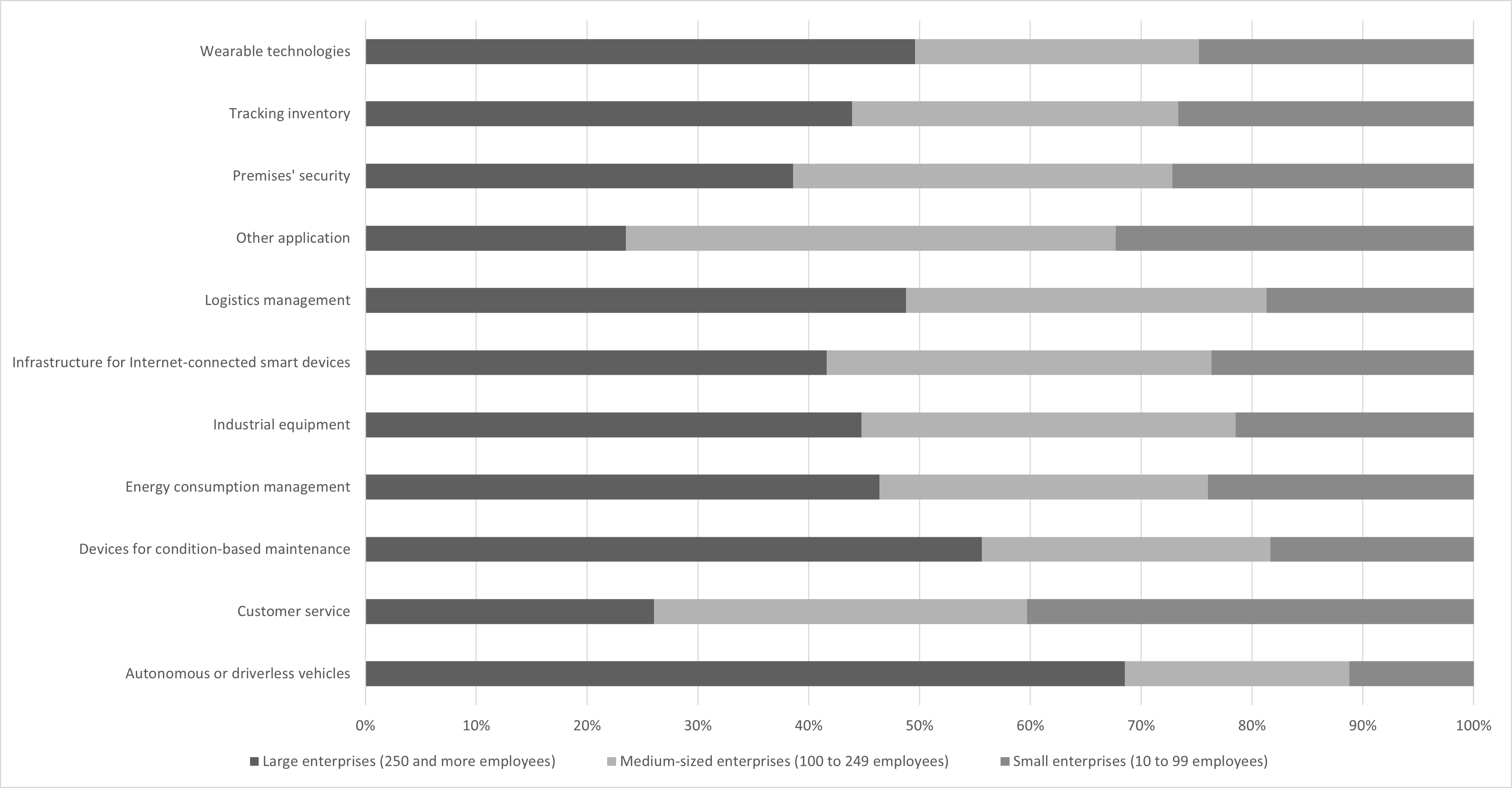Transforming the Way we do Business
Digital Solutions
Statistics Canada released a report in July of 2023 (1 ) with data collected on the use of applications related to Internet-connected smart devices or systems, for all industries, across Canada. The data collected came from a survey conducted in 2022 and includes data points from organizations of all sizes. When evaluating the information, it confirms digital solutions have become an integral part of the business landscape.
Some interesting data points –
- 44% of applications used by large Enterprise (>= 250 employees) organizations is to support infrastructure.
- Small- (1 0 to 99 employees) and medium-sized (1 00 to 249 employees) organizations invested more heavily into customer service applications. Respectively, 48% and 40%.
- All organization sizes invested the least in autonomous or driverless vehicle applications.
The applications are the digital solutions of today and offer a wide range of ways to help organizations streamline through innovation. From cloud computing and data analytics to artificial intelligence and smart infrastructure, digital solutions have the power to transform.
Future-thinking leaders are evolving their organizations to meet the demands of business strategy and reduce costs with innovative digital solutions. This approach has led to great gains for many organizations who need to run lean.
History has shown a shift in consumer behavior, such as those seen during and post-pandemic, has great influence. The transformation organizations have undergone, in such little time and how we now transact, has been necessary for survival(2).
The pandemic was a catalyst for transformations taking place across industries like healthcare, construction, finance and retail. It was the pivot for many to embrace automated workflow, Al and improve efficiency. Organizations needed to centralize and move to the cloud to support remote work efforts. Even with the latest return to office mandates, organizations still benefit deeply from the cloud systems to keep the operations running.
In this blog post, we will explore the digital solutions and how they are changing how we do business.
(1) Source: Stats Can Report published July 2023
(2) Source: FinancesOnline.com
Streamlining Workflow with Digital Solutions
Organizations streamline to be able to do more tasks in a given day. When streamlining using a digital solution, key elements are automation, built-in integrations, easy to use interfaces and… Al capabilities.
Streamlining provides an opportunity to introduce Artificial Intelligence (Al) programming to help with identifying trends or risks, quickly. The finance industry benefits from Al for uncovering audit issues, fraud and other risky transactions. Retailers are certainly benefitting from Al and specifically generative Al when implemented properly to handle customers.
Automation is a big game changer for many organizations who want to streamline. Popular initiatives by many are to automate sales and marketing team flows. Reworking of the flows ensures customer relationship engagement activities are personalized and timely. Other popular automations include: Automatic posting of transactions from eCommerce channels to cloud accounting systems;
Automatic transformation of data consumed from CRMs, ERPs, cloud resource monitoring systems (i.e. web analytics, AWS or Azure logs) to analytic warehouses for use in real-time organization analytics and insights; and
All this automation has a great benefit of improving productivity of teams. It certainly does not mean team members can put their feet up and just monitor the statistics on a dashboard.
Automation does allow team members to put their focus on tasks that require a more cognitive approach to problem solving. The human element is still a necessity in everyday business dealings to maintain empathetic approaches. With the introduction of automation to handle repetitive tasks, team members productivity naturally increases.
Automation relies on integrated systems which is not a new concept. It is however a much more accessible trend that organizations lean into and understand are helpful. It enables the automated workflows to easily and securely move data from system to system. Integration also enables many workforces to manage privileged access using centralized management tools from providers like Microsoft.
With the increase of automated and integrated systems, the need for good user experiences is a focal point. Ensuring applications are easy to use, means lower costs to onboard, improved employee satisfaction and minimal investment to upskill team members.

Data-Driven Decision Making
Team members are also benefitting from digital solutions powered by algorithms to handle large volumes of data. Every task results in data collected and summarized to trend activities and statistics. Being able to aggregate data in large volumes serves the healthcare and retail industry very well.
It provides insightful predictions to help manage the number of staff required or the potential for disease outbreak
The retail industry has been tapping into centralized data analytics for years. Using it to make improvements to SEO and SEM efforts and hone the spend for every conversion made.
The finance industry does not fall short of benefiting from analysis of large volumes of data. Large volumes of data provide valuable insights for day to day fraud detection.
Collecting all of this data, in any industry, allows for fact-based predictions with the ability to define the future of an organization. When aggregating data sets in large volumes, predictions become simplified and the margin for error reduced. Acknowledging the presence of anomalies, the data is the best resource. Time and time again, predications have proven correct.
This is when education comes into play. Making sure the organization as a whole has a healthy respect for insights it can gain. It provides teams and leaders with the “kick in the butt” needed to make changes fast.
Digital Solutions Enhance Customer Experiences
The data analytics help organizations who want to personalize experiences. This shift has come into focus and digital solutions only amplify the ability to make it happen. It has led to the creation of roles and the introduction of tools to help with delivering these experiences. It is a huge time saver and can, if implemented properly, be a cost savings mechanism as well.
Some believe digital solutions with Al will mean people losing jobs. However I see it as an opportunity. People usually spend hours answering customer requests but now they can help improve Al systems and do more in less time.

How Digital Solutions Transform Industries
This article has explored some high level ways digital solutions has transformed experiences, provide real-time analytics and improved efficiencies.
In this section of the article, I’m going to dive deeper into industries to highlight key transformations.
Retail organizations saw a shift during the pandemic and many had to quickly convert to an online presence. The need to meet demand and provide the consumer a way to purchase was a must do.
Retailers are now looking at ways to streamline operations by introducing digital solutions consisting of omnichannel tech and generative Al experiences.
I don’t see that as a threat to roles today as some may think. Organizations will train their teams to manage Al systems which will go a long way with maintaining authentic customer loyalty.
Customer loyalty is often built by providing great experiences and providing value for every dollar spent. Retailers using secure systems to capture customer data and personalize the shopping experience provide the customer with the benefits needed to sustain loyalty.
Vendors who make software to capture data have certainly made it very user friendly to analyze and use the data through their recommendation engines that are built right into most eCommerce platforms.
Amazon is ahead of the curve in inventory delivery systems with a digital system born out of consumer demand. They adopted a “digital-first” supply chain strategy that involved tapping into analytics for insights into what needs to be stocked. While seemingly a large scale for some, it’s a model that can be applied to a retailer of any size.
The advances of digital banking and mobile payments has been steady for a very long time. More organizations are adopting payments in traditional and non-traditional currencies. Not all of which have been regulated but in time it will happen. The increase in conversions from bricks-and-mortar to eCommerce is placing a huge demand on digital banking solutions.
With the rise of digital banking and mobile payments comes the demand for better fraud detection and better yet, fraud prevention. Digital solutions combining the best of fraud detection and prevention are quickly becoming the normal companion to most eCommerce type setups as a result of the increased ability for more exposure to persons who may circumvent controls.
The "Obvious" Challenges and Opportunities
I can’t in good conscience boast about and recommend embracing digital solutions without touching on the negative aspects. It’s to heed caution when putting solutions in place. I highly recommend careful planning and educating users when considering implementation. It will minimize occurrences of cybersecurity issues.
Security is a hot topic for the current times and likely not to let up anytime soon. Organizations adopting digital solutions to manage customers data are subject to stringent policies for protecting sensitive information. When considering a digital solution, don’t skip key activities like establishing terms of use, governing protocols and teams responsible for patching and updating systems.
Those individuals help organizations implement robust security measures and are the optimal augmentation to any team. Their focus on security ensures that at all times your losses and risk are mitigated.
In conclusion, taking responsibility for ensuring proper digital solution adoption and transformations can transform the way we do business. By enhancing efficiency, decision making, and customer experiences, companies are transforming industry practices and level-setting our future interactions. However, they also face challenges such as cybersecurity threats and the growing skills gap.
If organizations prioritize addressing these challenges, a digital solution can unleash their full potential to help grow organizations.


